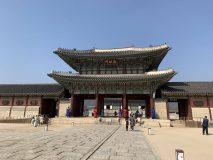MASQUERADE; CHOO CHANG MIN, 2012
Gyeongbokgung, 161 Sajik-ro, Jongno-gu, Seoul
Gyeongbokgung is an ancient palace located in the middle of a modern metropolis. The history behind it is a tedious one, so in this paragraph I will only give a few important facts about this palace. Gyeongbokgung was originally constructed in 1394 by King Taejo, the first king and the founder of the Joseon dynasty. It has existed for a long time, longer than all of us. In our deeply Confucian society, its significance and seniority invite respect. It is no wonder that the palace appears so frequently in Korean films.
One of the most prominent films in which Gyeongbokgung plays an important role is Masquerade (2012). The plot of the movie is simply a variation on a trite theme that was also treated by Mark Twain in his The Prince and the Pauper. One day, a beggar becomes the King of Joseon, and the former King of Joseon becomes a beggar. This odd exchange was made possible by the striking resemblance that exists between them. As time passes, the former beggar begins acting like a king, and the former king begins acting like a beggar. The moral of the story is simple and clear: nurture wins over nature.
Throughout the film, Gyeongbokgung is portrayed as a place where the former beggar, now forced to act like a king, feels constantly agitated. As an outsider, he finds it difficult to adapt himself to the strict, ossified culture inside the palace. In the movie, the palace is a symbol of royalty, something that is denied to ordinary people. The contrast between the place he used to live as a beggar and the palace he now lives as the King of Joseon is consistently emphasized. However, as the film progresses, the former beggar becomes completely acclimatized to the new environment, to the new role. Through this, the film illustrates how a ‘change of place’ determines the character of a person. Gyeongbokgung comes to shape and molds the structure of his thinking, his life, his worldview, and his everything.
As a Korean, I find some important discrepancies between how the palace is perceived in the present and how it was perceived in the past. In this century of democracy and nominal classlessness, everyone is allowed to walk around the palace. If you wear Korean traditional clothes, you are free to go in. Otherwise, you can walk into the palace after paying an entrance fee incomparably cheaper than a cup of coffee. Inside the palace, you see penniless couples taking selfies and children frolicking around. This would have been unimaginable in the past. The palace, where kings used to make decisions that would change the course of history, has become a playground for Koreans, a necessary part of our daily lives.
As I walked around the palace in order to collect visual material, I was surprised by how time, the inducer of all changes, has completely transformed the role of Gyeongbokgung. In the past, it was a symbol of glory, something that must be looked up to. Now, it is a symbol of democracy, something that is shared with people of all backgrounds.




Yumin Kim, 3035745740
You made some interesting observations about the role of Gyeongbokgung in the film as well as how it is experienced as a space in reality from the fieldwork you conducted. However, you can tie your analysis closer to the film itself. You may like to make closer observations of particular scenes, and include some stills from the film to compare with the photos you took. You are also reminded to cite any references used.